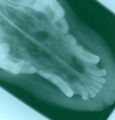| This article is still under construction. |
Description
Aspergillosis is a disease of the respiratory system caused by several Aspergillus spp. A. fumigatus is the most frequently reported species in domestic animals. Commonly affected species include birds, dogs, cats, horses and cattle but the disease has been reported in many other wild and domestic species.
Clinical signs and features
Birds
In avian species the disease manifests as a diffuse infection of the air sacs. Two forms of the disease have been reported; a diffuse pneumonic form and a nodular form involving the lungs. Clinical signs include diarrhoes, listlessness, pyrexia, loss of appetite and loss of condition. Seizures may occasionally occur.
Cattle
Infection in cattle may cause abortion and ocular infections. Infections involved the uterus, foetal membranes and foetal skin. Lesions are usually up to 2mm in diameter and contain asteroid bodies with a germinated spore in the centre. Acute infection causes miliary lesions and chronic infections causes granulomatous and calcified lesions.
Horses
In the horse the guttural pouches are most commonly affected. Aspergillus infection may also lead to abortion.
Dogs
Aspergillosis is a common cause of nasal disease in dogs. Cases occur most commonly in young to middle aged male dogs, but animals of all age and of both sexes may be affected. Doliocephalic breeds are thought to be overrepresented. Clinical signs are those seens with any chronic nasal disease and include sneezing, unilateral or bilateral serosanguinous nasal discharge, ulceration of the nares, nasal pain and epistaxis. The disease is usually localised to the paranasal sinuses and nasal cavity but a disseminated form with granulomas and infarcts has been reported in dogs, particularly German Shephards. The disease often involves multiple organ systems including the spleen and kidneys. Clinical signs include lethargy, anorexia, haematuria, urinary incontinence and haematuria. The vertebrae are frequently affected and osteomyelitis and discospondlylitis are common features.
Diagnosis
In dogs, radiology is often peformed in the diagnostic work up of an animal with suspected Aspergillosis. Open-mouth ventro-dorsal views often reveal generalised radiolucency and lysis of the turbinate bones. Rhinoscopy may be used to directly visualise the lesions, revealing characteristic white-green fungal plaques.
- Grows on Sabauraud's Dextrose and Blood agar
- White colonies intitially which turn green, then dark green, flat and velvety
- Colony colour varies with species
- Also grows on Czapek-Dox agar and 2% malt extract agar supplemented with antibacterial antibiotics
- Microscopically:
- Conidiophores with large terminal vesicles (only visible in the lungs and air sacs where there is access to oxygen)
- Vesicle shape varies depending on the species
- Is a common contaminant so repeated tests should be done for a definitive diagnosis
- Conidiophores with large terminal vesicles (only visible in the lungs and air sacs where there is access to oxygen)
- Serology:
- Gel immunodiffusion for canine nasal asper
- Treatment:
- Surgery
- Antifungal drugs
- Pathology:
- Aspergillus fumigatus causes rhinitis, respiratory tract inflammation and sinusitis
- Sometimes appears on lesions of ethmoidal haematoma
Treatment
In dogs, the treatment of choice is topical application of Clotrimazole. It is admnistered via indwelling catheters placed through a trephine hole in the frontal sinus.










